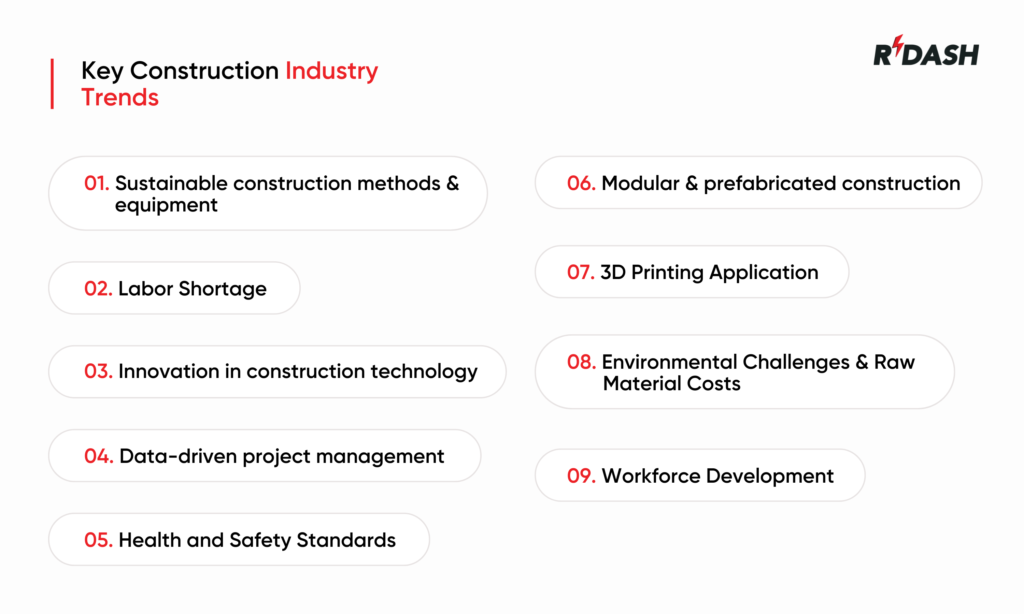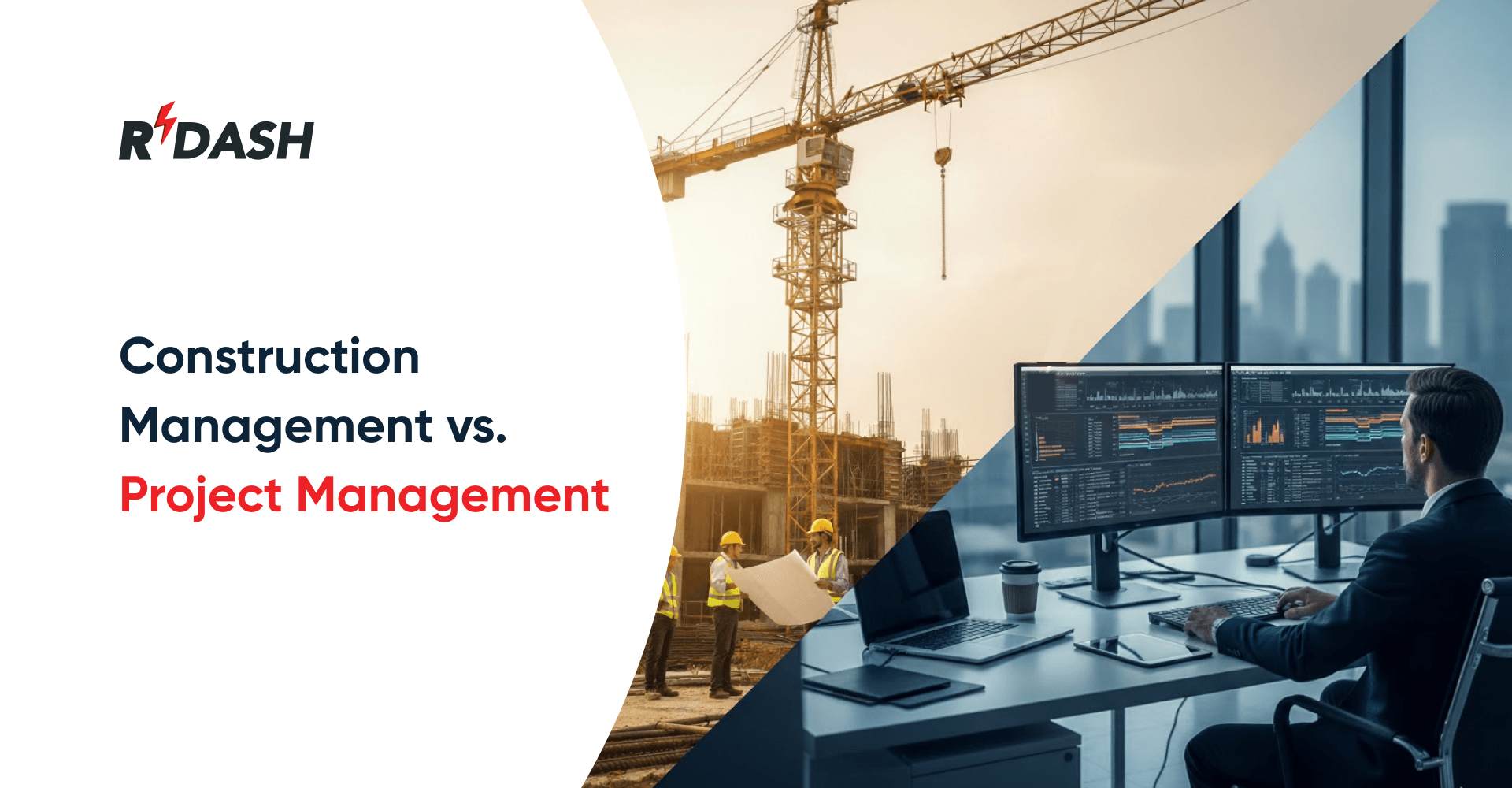New challenges and innovative ideas are significantly transforming the construction industry. These advancements are steering us towards adopting more sustainable practices and focusing on creating healthier building environments. As these changes take place, it becomes increasingly important to reevaluate and update our design and building methods. Doing so ensures that our constructed spaces are well-prepared to meet the demands of the future.
Key construction industry trends
Let’s take a look at those key trends shaping construction’s future and how they are impacting the industry today.

1. Advancing sustainable construction methods and equipment
The construction sector is following the greener practice bandwagon by using greener equipment. Several organizations depend on energy-efficient design, renewable energy sources, and sustainable building materials such as recycled steel and cross-laminated timber.
Techniques include green construction such as passive solar design and rainwater harvesting that have become the norm, while the manufacturer of heavy machinery is coming up with electric and hybrid machinery to minimize emissions. Then, there are even LEED certificates that encourage contractors to embrace green practices. Such initiatives help ensure a safer environment while setting a company up for a good reputation and increased profitability over time.
2. Labor Shortage
The labor shortage is a general challenge for the construction industry. Having an aging workforce and reduced interest in the trades among younger generations makes this gap quite high. Not only does the project suffer from delay, but the cost of the project goes up as companies fight over the scarce pools of skilled workers.
Automating the processes is an efficient way to address this problem, optimizing routine operations. Collaboration with academic institutions is also a good strategy, providing access to newly skilled labor, which may enhance your competitiveness in a tight job market. These strategies ensure that your projects remain on schedule, even amidst workforce shortages.
3. Innovation in new construction technology

The construction sector is no longer just about bricks and mortar. Advanced technologies like Building Information Modeling (BIM), drones, AI, and augmented reality (AR) are reshaping the way projects are planned and executed. These technological innovations are changing the mechanisms used in planning and executing projects. For instance, with BIM, architects, engineers, and contractors are united in their collaborative efforts through digital representations of buildings before these are constructed.
Drones permit regular scoping of sites, sighting construction work in progress, and checking for safety. Augmented reality brings newfound vitality to project design visualization, allowing walk-throughs by clients before a brick is laid. Artificial intelligence in project management offers predictive insights into scheduling, optimizing available time and enhancing overall efficiency. Such technologies consume time but give cost and error reductions marking razor-thin margins in an industry.
4. Data-driven project management
Data-driven project management tools provide real-time insights into cost control, scheduling, risk management, and resource allocation. More so, platforms like RDash and Autodesk Construction Cloud help drive teams’ smooth collaboration while further tracking the progress of a project with pin-point accuracy.
These tools really help manage projects better and make subcontractors talk better to each other. They are easy to work in teams and solve problems promptly before small issues become huge problems. With these technologies, you can do great work and stay on budget, too, and everything will stay on schedule.
5. Health and Safety Standards

Health and safety have long been understood in construction, but the COVID-19 pandemic drove home the message more than ever. These factors led companies to increase their efforts to create safer work environments and implement stricter safety protocols. Some of these include different types of wearable technology such as smart helmets and vests used to monitor a worker’s vital signs and ensure that what they are doing is safe.
Some examples include AI-driven safety systems and live identification of hazards at construction sites. Training programs improved through the formulation of the culture of safety and arming workers with the information that would prevent injuries when an accident happens in the workplace. How companies can create health and safety leads to reduced accidents, the protection of the workforce, and avoidance of costly legal and insurance claims.
6. Modular and prefabricated construction
Those days are gone when one could only think of building on-site. Modular and prefabricated construction have gained immense momentum in the light of speed and efficiency. The waste can be reduced; the quality may be improved and the construction period dramatically reduced by constructing small pieces off-site in controlled environments by organizations.
For example, all the walls, floors, and roofs of an entire section of buildings can be manufactured in a factory and wheeled to site for assembly. This approach has been indispensable for housing estates, schools, and even hospitals where speed is truly invaluable. Modular construction also synergizes well with the push toward sustainability by minimizing material waste and on-site disruptions.
7. 3D Printing Application
While once being a futuristic concept, 3D printing has rapidly become an integral part of construction. But it is now used for the creation of intricate architectural models for the building of entire houses. Innovation offers 3D printing with unparalleled speed and precision, making companies able to produce components with minimal waste and labor costs. 3D Printing: Trend Application in low-cost housing Affordable housing is another exciting trend of 3D printing. It’s wherein companies print house components layer by layer using concrete or bioplastics, offering low-cost and sustainable housing to the people who need it most. This also stretches to custom parts and repair, making production quicker and more flexible as designs can be changed rapidly.
8. Environmental Challenges and Raw Material Costs
Supply chain disruptions and fluctuating material costs continue to be major concerns for construction companies. The COVID-19 pandemic exposed vulnerabilities in global supply chains, and ongoing geopolitical tensions have further compounded the issue. Shortages of critical materials like steel, lumber, and concrete have driven up costs, forcing contractors to rethink procurement strategies.
Local suppliers are the focus of many firms today, allowing for reduction in international shipping dependence. Advanced logistics equipment also streamline the way materials are managed. Better materials, such as self-healing concrete and carbon fiber, are under research for other alternatives that yield the profit in two dimensions: relatively affordable and green. Proactive management of supply chains also minimizes delay and helps maintain projects within budget.
9. Workforce Development
Strong investment through training programs and initiatives to upgrade the current workforce toward the requirements of modern construction is the way different construction companies are working in the process. Collaboration with institutes and even government agencies as well as trade organizations help to establish programs that teach everything from old, traditional craftsmanship to the latest technology in the field.
Most importantly, mentorship programs and career advancement opportunities are fast becoming commonplace; this encourages one to view construction as a long-term, rewarding career. In this way, workforce development for companies can be guaranteed, with a consistent pipeline of skilled professionals ready to meet the challenges of tomorrow.
New technologies, modular construction, and sustainable practices not only make the sector leaner and more efficient but also chart out a roadmap to a green, resilience-increasing future.
Most important, development of the workforce, supply chain problems, and safety regulations will ensure the strength and resiliency of the sector. Embracing these trends will force construction firms to be ahead of the curve, to deliver better projects, and to contribute to a world that is functional but, above all, future forward. Construction’s bright future, with the right strategies, can thrive in this changing landscape.






